AutoChem III is a single analytical device that can function as a catalyst characterization laboratory.
- Improved sample and gas temperature control, innovative gas blending, and 100% improvement in sensor sensitivity result in industry-leading accuracy
- Users can save hours daily with quick cooling, a non-cryogenic moisture trap for TPR, and the most readily available pre-plumbed gas streams.
- Eliminate the need for glass vacuum dewars, cryogenic liquids, and labor-intensive hot fitting operations to increase operator safety.
Description
AutoChem III
Micromeritics’ AutoChem is the most extensively used and cited method for determining catalyst reactivity since it is also the most automated and precise device for chemisorption and temperature-programmed reactions.
The all-new AutoChem III meets and surpasses that performance with a design that saves users hours each day, provides the most sensitive, reproducible measurements, and improves operator safety.
- Pulse Chemisorption
- TPR
- TPO
- TPD
- TPSR
- Dynamic B.E.T.
- Breakthrough Curve
- Metal Dispersion
- Metal Surface Area
- Active Surface Area
- Crystallite Size
- Heat Of Desorption
- Activation Energy
- B.E.T. Surface Area
- Metal-Supported Catalysts
- Acid or Base Catalyzed Reactions
- Oxide or Zeolite Catalysts
- Advanced Battery Anode Materials
- Fuel Cell Catalysts
Benefits
AutoChem III Benefits
Quick and Easy
With the new AutoChem III, users can save hours a day using its quick and simple vital functions, which frees up more time for advancement rather than measurements.
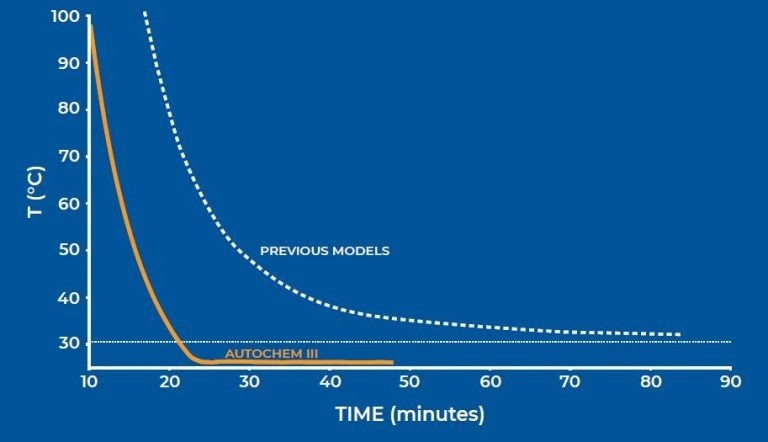
Rapid Turnaround Time with Autocool. Image Credit: Micromeritics Instrument Corporation
An integrated gas-fed system called the NEW AutoCool quickly cools sample tubes before and during tests. Compared to other methods, AutoCool often cools down 30 minutes faster and does not require any extra assistance or liquids.
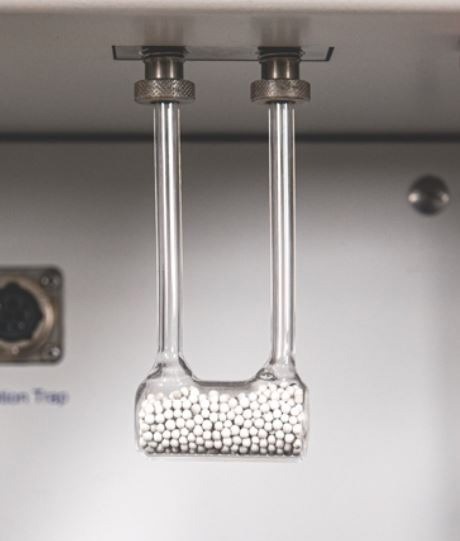
Never Prepare Another Vapor Capture Slush Bath. Image Credit: Micromeritics Instrument Corporation
The NEW AutoTrap efficiently traps vapor without manual slush bath preparation.
Conventional vapor capture techniques need a labor-intensive slush-bath preparation procedure, including manually mixing isopropanol and liquid nitrogen. The AutoTrap’s zeolite bed is capable of in situ regeneration, continuous usage for several experiments, and efficient vapor collection.
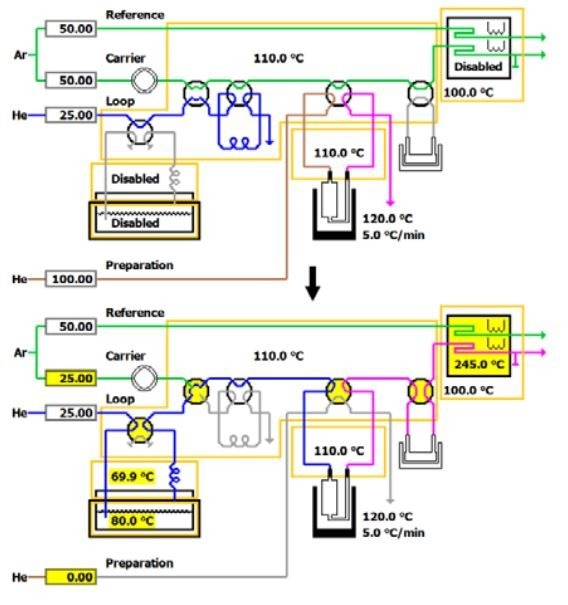
Program What You Envision, Visualize What You Have Programmed. Image Credit: Micromeritics Instrument Corporation
To ensure that the approach aligns with the vision, the new MicroActive method editor includes an easy-to-use process depiction that displays the instrument’s programmed state at each stage of the method.
Making Accuracy Easy
Exclusive Automated Detector Calibration
The automated detector calibration of the AutoChem III simplifies quantitative accuracy. Conventional systems need to be calibrated using numerous runs of reference materials or single-point offsets that fail to account for variations in pressure or temperature.
Using its revolutionary gas blending capabilities, the AutoChem III ensures the highest calibration and result accuracy level through a completely automated procedure that accounts for injection loop temperature and pressure. Compared to other designs, the procedure yields more precise findings and is quick and automated, requiring no involvement from the operator.
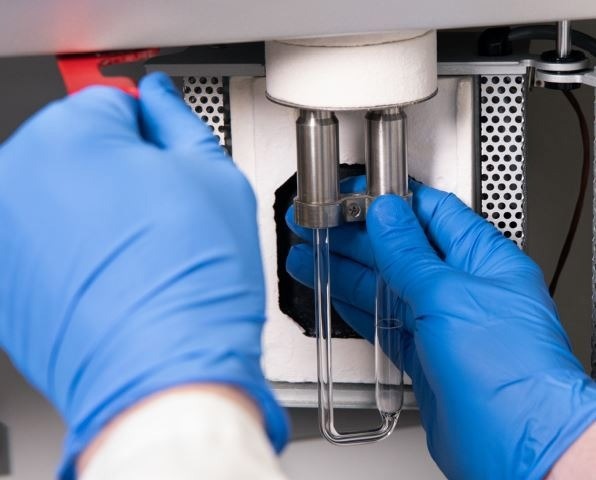
Loading Samples is a Snap. Image Credit: Micromeritics Instrument Corporation
With half as many different parts and no threaded fittings as past designs, the patented new KwikConnect design facilitates sample tube insertion in a faster, simpler, and more dependable way. Sample tubes are less likely to break during installation and elimination, and the snap lock closure ensures the system is entirely sealed.

Ready to Run With 18 Available Gas Streams. Image Credit: Micromeritics Instrument Corporation
Users do not need to spend time disconnecting and switching gas lines; they have everything ready when needed. The AutoChem III features 18 accessible gas streams, ensuring users are ready to execute their next reaction.
Having the correct blended gas on hand also ensures that users will neither add mistakes from poorly designed external gas connections nor compromise data accuracy by blending gases, which introduces unnecessary errors from mass flow controllers.
Better Measurements for More Confident Decisions
The AutoChem III produces results that enable confident judgments. The best available measurement precision and repeatability, obtained under settings that mirror the reaction environment, allow users to act confidently.
Precision Temperature Control
Maintaining the deactivation of valuable catalyst materials while simulating reaction conditions requires precise temperature precision. Every major performance criterion is where the AutoChem III outperforms all other systems.
- Widest range of temperatures: -100 °C to 1200 °C
- Widest range of heating rates: 0.1 °C/min to 100 °C/min
- Repeatable temperature profiles
- Accurate determination of activation energy, Ea
- Local sample temperature measurement
- Superior control accuracy without overshoots
- Vapor condensation is eliminated, and measurement stability is improved by four independently regulated gas stream temperature zones.
Most Accurate Gas Stream Composition
AutoChem III has the lowest gas flow route volume when gas flow conditions change to prevent signal tailing and carryover. This ensures accurate composition of the gas stream even while varying configurations from one experiment to another.
With 18 gas inlets accessible, users can combine gases in situ without making mistakes while keeping the necessary gas composition available.
- Better Temperature Control at Every Step
- Furnace: to simulate reaction conditions
- Vapor: to control vapor composition
- Gas Stream: to maximize detection sensitivity
- Detector: to guarantee robustness
See More of User’s Reaction with the Most Sensitive Chemisorption System in the World
A new thermal conductivity detector (TCD) in the AutoChem III is 110% more sensitive than those in earlier models. As a result, users can use smaller sample sizes, identify secondary reactions with more precision, and obtain better accuracy for catalyst characteristics like site coverage.
A reference stream with a specialized mass flow controller (MFC) that offers a steady reference to the sample stream improves detector sensitivity. Other systems cause interference between the measurement and reference streams, which causes signal instability by using a shared carrier stream for both the reference and the signal channels.
The temperature-controlled TCD is a durable sensor that has an extended lifespan and built-in defense against operational mistakes such as gas flow leaks, which lead to the early failure of 4-element detectors utilized in subpar designs.
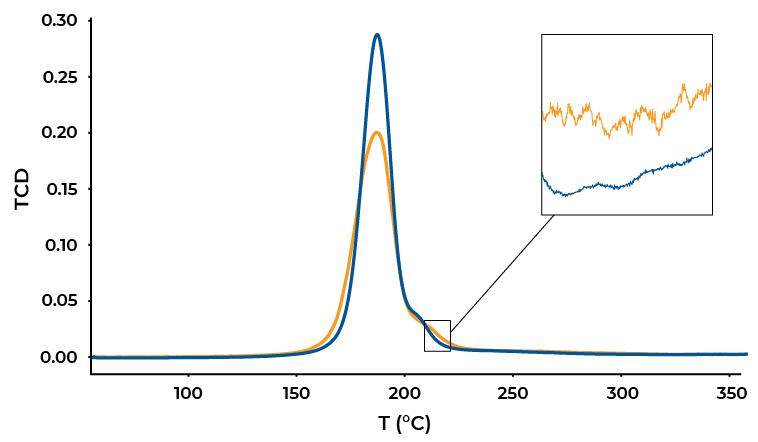
Image Credit: Micromeritics Instrument Corporation
Continuous Controlled Vapor Dosing
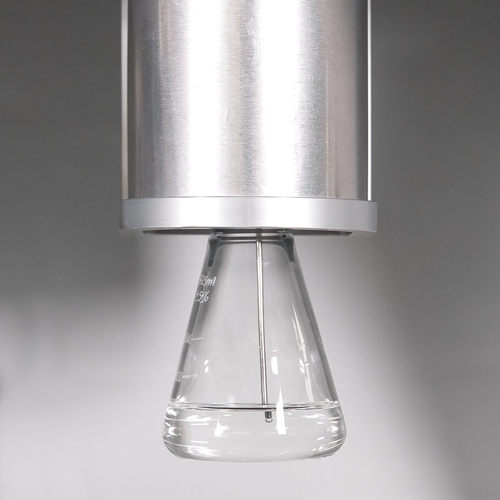
Image Credit: Micromeritics Instrument Corporation
With the available vapor generator that offers automated vapor calibration, injection repeatability greater than 1%, and all-new continuous dosing capabilities, users can achieve quicker analysis and more thorough surface selectivity and functionality characterization.
The TPD sample preparation process, called the reaction gas stream, uses this system to produce consistent streams of saturated vapors, such as water, alcohols, amines, or organics.
Compared to older systems restricted to discrete vapor stream pulses, the new continuous dosing feature allows for quicker and more consistent vapor dosage.
Move Quickly from Data to Decision
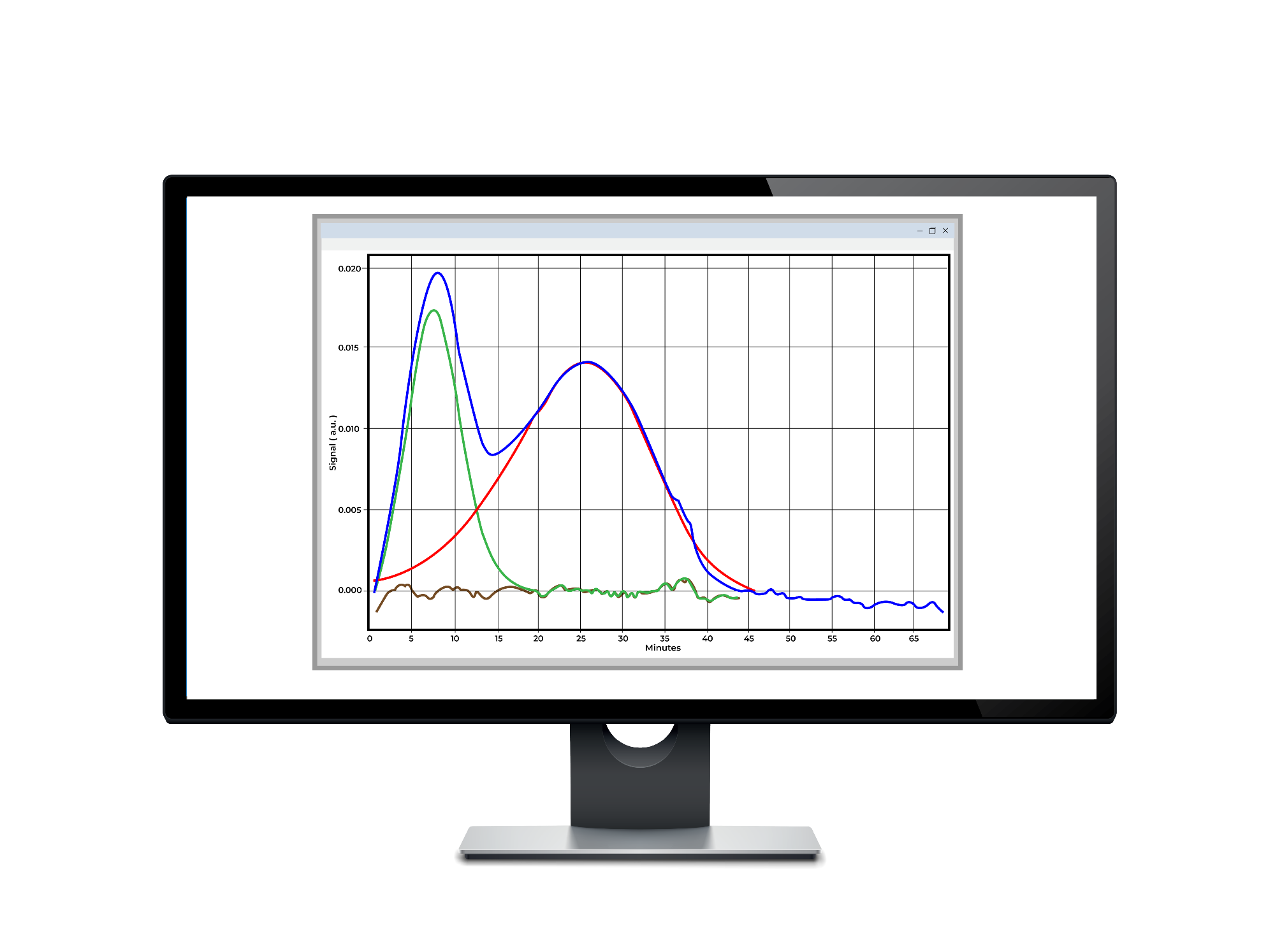
Image Credit: Micromeritics Instrument Corporation
Micromeritics’ AutoChem data processing program allows users to convert from experimental data to material properties quickly. Find all the answers required with:
- Interactive peak analysis consists of limit selection, baseline determination, integration, and deconvolution
- Built-in analytical models include pulse chemisorption, percentage dispersion, metal surface area, crystallite size, first-order kinetics, heat of desorption, activation energy, BET, Langmuir, total pore volume, and others.
- Smooth incorporation of mass spec data
- Detailed, configurable graphical reports
Improving Operator Safety
At every level of the measuring process, the AutoChem III increases operator safety by minimizing exposure chances and potentially dangerous situations.
No Cryogenic Liquids
Without using cryogenic liquids like liquid nitrogen, the revolutionary AutoTrap eliminates moisture. Additionally, the AutoTrap removes the requirement for preparing slush baths, which involve vigorously mixing solvents and alcohols in glass vacuum flasks.
Cool to the Touch
After each experiment, the new AutoCool rapidly returns sample tubes to ambient temperature so that users can quickly swap out samples and begin the next experiment without having to handle hot glass sample tubes. Additionally, users may release the sample tube with one motion thanks to the KwikConnect sample tube retention mechanism, saving them time and hassle from having to juggle various adapter parts and threaded connections.
Features
AutoChem III Features
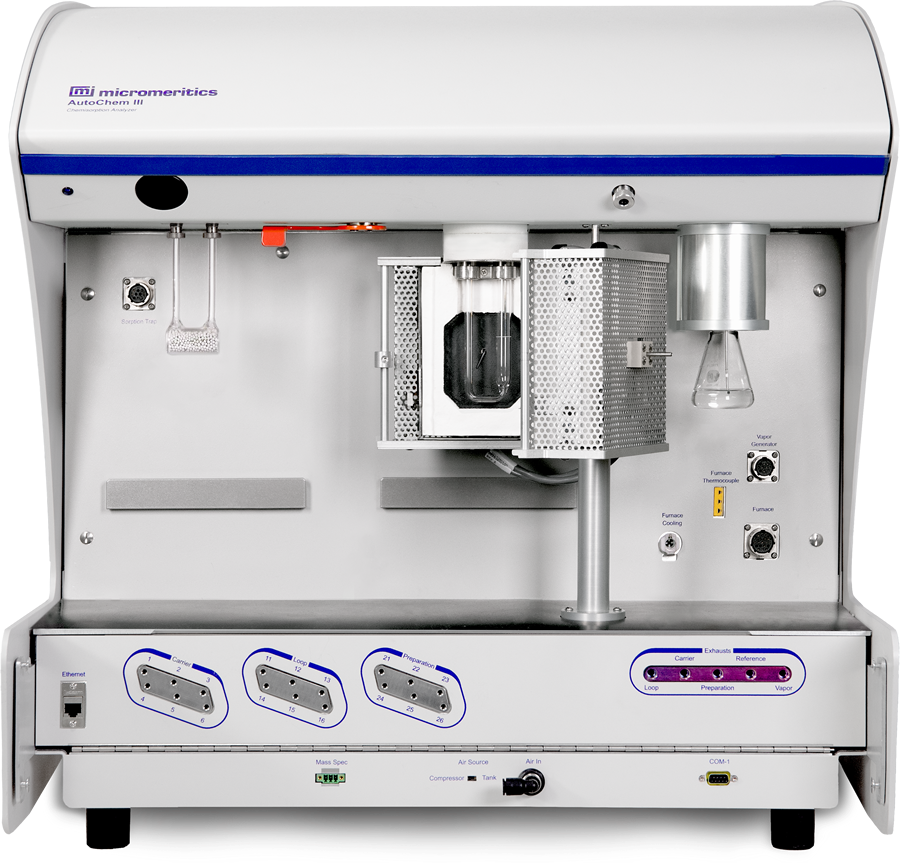
Image Credit: Micromeritics Instrument Corporation
AutoChem III Feature List
- Temperature-controlled corrosion-resistant detectors have a long operating life and good reliability because they are compatible with corrosive gases and are intrinsically shielded against gas leaks that can ruin other designs.
- With two times the sensitivity of other options, the high-sensitivity thermal conductivity detector (TCD) allows users to test smaller sample quantities, identify secondary reactions, and feel more confident in their results.
- With a system that is easy to use and saves hours every day, Exclusive AutoTrap offers exceptional moisture removal for TPR tests. There are 18 total gas inlets—six for preparation, carrier, and loop gases—that allow for consecutive experiments of various kinds and save time in between experiments.
- The lowest possible temperature overshoot is achieved with a dynamic clamshell furnace, which offers temperature control up to 1200 °C and adjustable heating rates from 0.1°C/min to 100 °C/min.
- Without cryogenic liquids, integrated auto-cooling cools the furnace and sample more quickly than forced air alone, saving an average of thirty minutes for each experiment.
- Internal gas temperature management in four distinct zones reduces condensation and enhances overall signal stability when conducting vapor experiments.
- When modifying the composition of the gas stream, the lowest internal gas volume reduces tailing and offers the maximum peak resolution.
- Sample tube attachment is quick, simple, and safe with the KwikConnect retention system since it has fewer parts than standard designs and does not require threaded connections.
Specifications
AutoChem III Specifications
Source: Micromeritics Instrument Corporation
| . |
. |
| Temperature |
Ambient to 1200 °C |
| Temperature Ramp Rates |
-100 °C to 800 °C: up to 100 °C/min
800 °C to 1000 °C: up to 50 °C/min
1000 °C to 1200 °C: up to 25 °C/min |
| Preparation gases |
6 inlets: H2, O2, He, Ar, H2/Ar, and more |
| Carrier gases |
6 inlets: He, Ar, H2/Ar, and more |
| Analysis (loop) gases |
He, H2, CO, O2, N2O, NH3/He, and more |
AutoChem III Capabilities
- Pulse Chemisorption
- Temperature-programmed reactions: TPR, TPO, TPD, TPSR
- Strong Chemisorption: Reactive metal area, dispersion, crystallite size
- Active site surface concentration
- Reduction, Oxidation Temperatures
- Acid site strength distribution: Lewis/Brønsted acid site distribution
- Breakthrough Curve Measurement
- Activation Energy
Optional Capabilities
- CryoCooler -100 °C to 1200 °C
- Detection by Mass Spec
- Continuous or Pulsed Vapor Dosing: water, alcohol, amines, aromatic organics, and more
- Enhanced Chemical Resistance
- B.E.T. Surface Area
Configurations
Mass Spectrometer (MS)
A direct method of determining the identification and concentration of certain reaction products is mass spectrometry, or MS. This is particularly helpful when looking at a reaction that is unclear or that produces several products.
The AutoChem III can detect mass fragments up to 200 amu and capture data in tandem with its operation, thanks to the single quadrupole mass spec with heated transfer line.
The AutoChem III also has a generic mass spec connection interface to work with a lab’s current mass spec.
Cryocooler
Begin trials at temperatures as low as –100 °C using controlled liquid-nitrogen cooling.
Vapor Generator
Prepare samples for analysis or measurements in the presence of pulsed or continuous vapor streams, including water, alcohol, pyridine, aromatic organics, and other compounds.
Enhanced Corrosion Resistance
An upgraded corrosion-resistant AutoChem III variant is offered for reaction chemistries that require extremely harsh gas compositions. To offer the best stability under the most demanding working circumstances, wetted materials are constructed out of very stable perfluoroelastomers, highly resistant Hastelloy, and inert-coated stainless steel.
Applications and Methods
Net Zero Technologies
The advancement of CO2 mitigation and the hydrogen economy, which will facilitate a sustainable energy future, depend on developing efficient and effective catalysts.
Optimizing H2/O2 adsorption and dissociation on electrolysis electrodes, determining if desorption happens close to reaction conditions, quantifying acid or base sites to maximize reactivity and selectivity, and other tasks could all be accomplished with the help of the AutoChem III.
Fuel Cells
Pt/C, PtRu/C, and PtRuIr/C are examples of platinum-based catalysts. They are frequently characterized by temperature-programmed reduction to ascertain the number of oxide phases and pulse chemisorption to compute metal dispersion, average crystallite size, and metal surface area.
Partial Oxidation
The following are the characteristics of the manganese, cobalt, bismuth, iron, copper, and silver catalysts used in the gas-phase oxidation of ammonia, methane, ethylene, and propylene: Temperature-controlled desorption and oxidation, as well as oxygen dissociation and desorption heat.
Catalytic Cracking
Gasoline and diesel fuel are produced from massive hydrocarbons by acid catalysts like zeolites. Temperature-programmed desorption and ammonia chemisorption are two methods used to characterize these materials.
Catalytic Reforming
To produce hydrogen, aromatics, and olefins, catalysts comprising platinum, rhenium, tin, etc., on silica, alumina, or silica-alumina are utilized.
Isomerization
To change linear paraffins into branched paraffins, catalysts with noble metals (usually platinum), such as small-pore zeolites (mordenite and ZSM-5), are utilized.
Hydrocracking: Hydrodesulfurization and Hydrodenitrogenation
Hydrocracking catalysts handle feeds containing polycyclic aromatics unsuitable for conventional catalytic cracking methods. These catalysts are often made of metal sulfides, such as nickel, tungsten, cobalt, and molybdenum.
Water Gas Shift Reaction
The water-gas shift reaction is an essential component of the hydrogen lifecycle and the drive toward net-zero technology. TPR and pulse chemisorption are features of the catalyst combination, often iron-chromia and copper-zinc-alumina to increase activity.
Methods
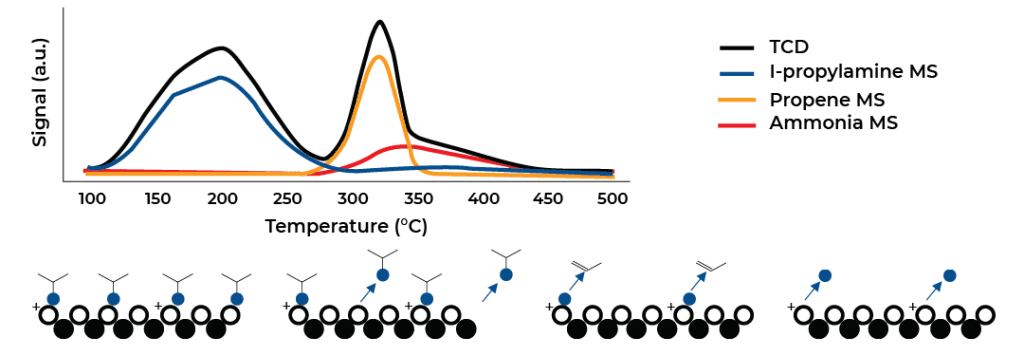
Temperature Programmed Reactions. Image Credit: Micromeritics Instrument Corporation
By altering the composition of the gas stream, the suite of temperature-programmed reactions is utilized to quantify reactivity as a function of temperature. The consumption of reactive gases, the production of reaction products, and the desorption of bound species all cause changes in the composition of the gas stream as temperature rises.
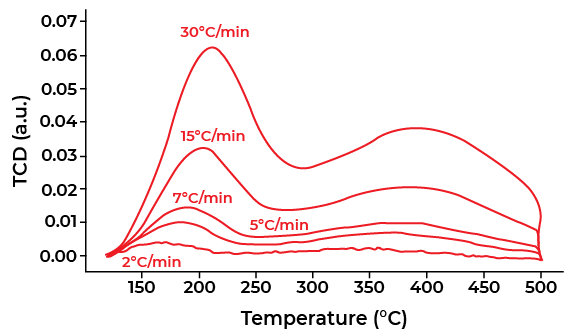
Temperature-Programmed Desorption Measurement (TPD). Image Credit: Micromeritics Instrument Corporation
It is possible to desorb previously adsorbed species by raising the sample temperature while an inert gas flows. Among the most popular uses is ammonia TPD. To determine the relative acid site strength of materials like zeolites, a sample is first saturated with ammonia during preparation and then heated to desorb-bound ammonia.
In the same way, carbon dioxide desorption reveals the strength of fundamental sites. It is also possible to describe carbonates to remove CO2 or hydrides for hydrogen storage by bulk breakdown into the gas phase.
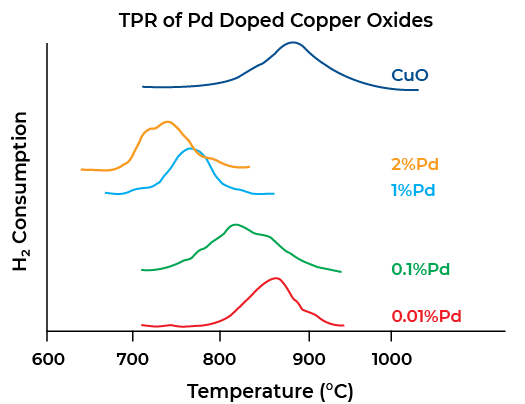
Temperature Programmed Reduction (TPR). Image Credit: Micromeritics Instrument Corporation
The TPR measurement is a particular instance of a temperature-programmed reaction in which an oxide sample is exposed to a mixture of hydrogen and an inert carrier, often argon. Water vapor is produced when hydrogen is extracted from the gas stream.
The AutoTrap captures the water vapor, and the hydrogen loss from the carrier stream is quantified. The temperature, time, and activation energy needed to develop a heterogeneous catalyst from its native oxide state into the active zero-valence metal is specifically provided by this measurement.
Temperature Programmed Oxidation (TPO)
When oxygen in the sample gas stream is consumed in a TPO experiment, it typically reacts with various types of carbon to create CO or CO2. TPO experiments are crucial to maximize process conditions and assess the reactivity of metal oxide catalysts.
Since the oxidation temperature is similarly correlated with the reactivity of carbon-carbon bonds, it is a useful tool for distinguishing between different carbon forms. TPO can discriminate between graphitic carbon, amorphous carbon, nanotubes, and filaments, particularly those that develop on catalysts.
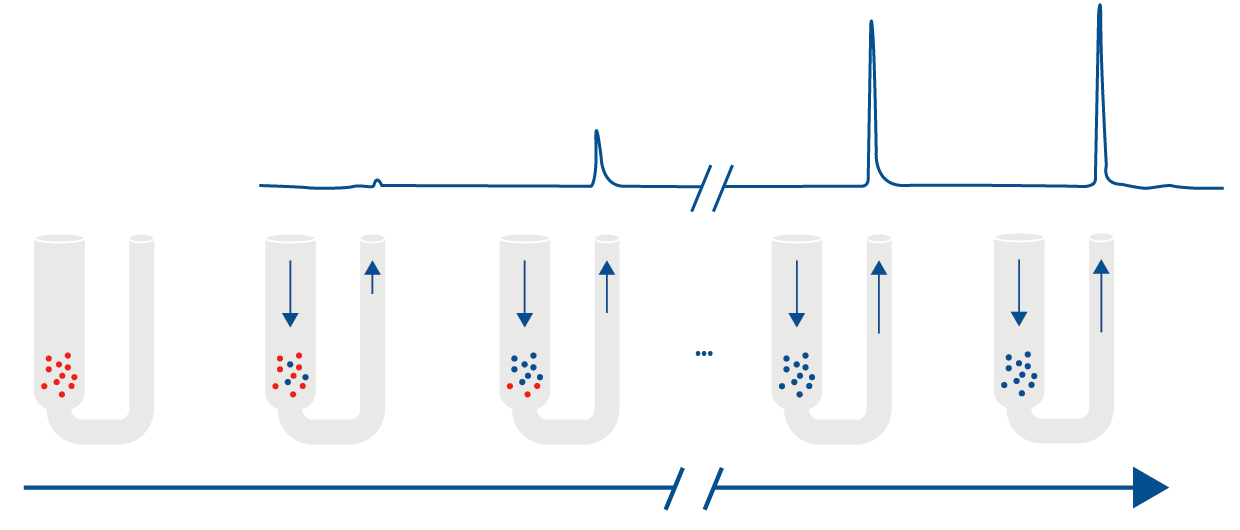
Pulse Chemisorption. Image Credit: Micromeritics Instrument Corporation
Applying temperature and gas exposure produces a sample in situ to a defined starting condition (such as pure oxide or valence metal). The device delivers known-volume reactive gas pulses to the sample and counts the gas used in each pulse.
B.E.T. Surface Area: Physisorption
The N2 added to or removed from a flowing gas stream at ambient or liquid nitrogen temperatures, respectively, is measured using the flowing or dynamic approach by the AutoChem III to determine the B.E.T surface area.
Since they show the fundamental physical shape of the catalyst and/or support as well as the accessible contact area for reactivity, basic physical surface area measurements are crucial for the development of catalysts. Additionally, for any porous and granular materials, this is a crucial fundamental measurement.
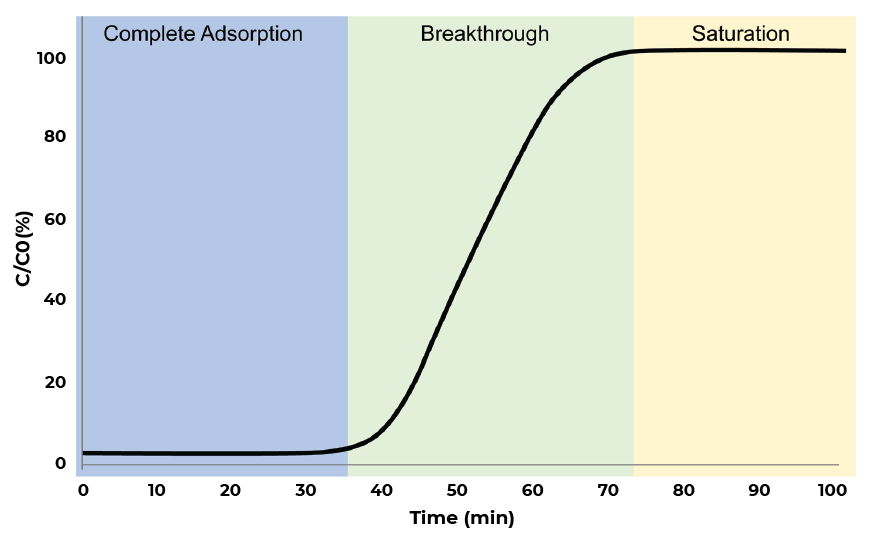
Breakthrough Curve Analysis. Image Credit: Micromeritics Instrument Corporation
Breakthrough analysis is a potent method for figuring out a material’s adsorption capacity in dynamic flow settings. During an experiment, breakthrough analysis enables users to accurately regulate the temperature, pressure, and gas flowrates. This gives users the tools they need to improve their systems and adsorbent materials for their application by enabling them to assess adsorbates under conditions relevant to their process.
Furthermore, breakthrough makes it easy for users to get multicomponent equilibrium adsorption data, which enables them to ascertain the materials' selectivity and adsorption kinetics.
THE MOST ADVANCED CHEMISORPTION SYSTEM IN THE WORLD| AUTOCHEM III
Video Credit: Micromeritics Instrument Corporation
Third-Party Tested and Verified
Products from Micromeritics are third-party tested to ensure that they meet the strictest operational safety and regulatory requirements. Install and operate the system with the assurance that it will satisfy, if not beyond, electrical safety regulations and be compatible without needing further certifications or evaluations.

Image Credit: Micromeritics Instrument Corporation